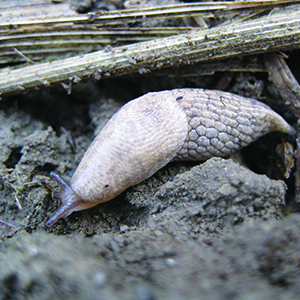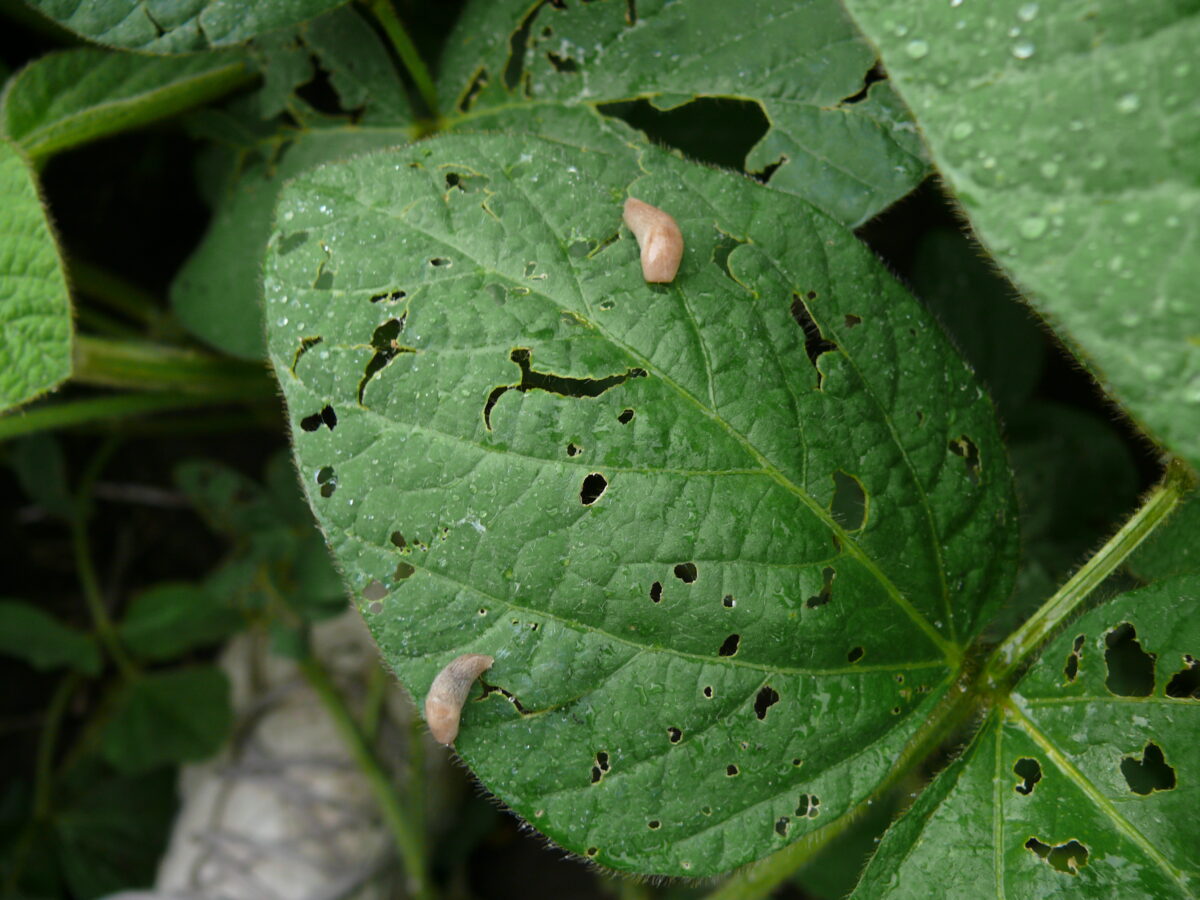Photo credit: B. Hall
Description
The primary crops at risk are corn, soybeans, newly seeded forages, and canola. Juvenile and adult slugs are soft-bodied, legless, greyish or mottled in appearance and have a slimy or gelatinous covering that protects them from drying out. They are essentially snails without a shell. The head has two pairs of tentacles, one of which holds their eyes. Slugs usually range from 1–3 cm (0.4–1.2 in.) in length but can reach up to 10 cm (4 in.)
Life Cycle
There is one generation per year but two populations, one maturing as adults in spring and one maturing as adults in fall. Therefore, damage can occur both in the spring and the fall on young developing plants. Both eggs and adults overwinter. Juvenile slugs are the most damaging stage of the pest life cycle. They hatch from eggs in the spring and the fall and are most active during cool and wet periods. Slugs prefer environments with high humidity and relatively cool temperatures. Debris, such as crop litter or manure, provides them with shelter from the sun.
Damage
Slugs feed above or below ground, depending on the moisture level. They can feed on germinating seeds and seedlings, with no real preference for a plant part. Slugs feed on lower parts of larger plants, partly or completely eating through leaves, resulting in ragged holes that cause a skeletonized appearance on leaves of broadleaf plants. In soybeans, cotyledons may be fed on or clipped, killing the growing point of the plant. In corn, strips are scraped of the leaves, resembling hail damage, however the growing point is rarely impacted. If slug populations are high, they may feed on germinating seeds, hollowing them out before they can emerge. Slime trails may be left on the soil or leaf surface.
Conditions that Increase Risk
Fields at risk include no-till corn, soybeans and canola (especially fields with considerable crop residue), wheat fields underseeded with red clover, newly seeded alfalfa and fields following mixed forages (especially grasses). Open-seed furrows provide ideal living space. Mild winters with thick snow cover followed by cool, wet cloudy springs or open falls increase risk. Knowing the slug population of each field in the fall will indicate how significant the problem will be the next spring. It is the same population that overwinters and feeds in the spring.
Scouting
Fall scouting can predict problem fields for next spring. Scout for slugs at night or in the early morning hours, when they are active (nocturnal). Look for gaps in the stand, stripping of leaf tissue and/ or small holes chewed in the leaves. Check under debris and clumps of soil. A sure sign of slugs is a slimy, silver-coloured trail on the plants or soil. To determine population levels, set up shelter traps, using 30 cm2 (1 ft2) pieces of white roofing material (preferred) or shingles, plywood or wet cardboard. Position each trap directly on the soil surface, brushing away any crop debris or residue, and place a rock on top to keep the trap from blowing away. Use 10–15 shelter traps randomly scattered across the field to provide a good indication of population levels. Visit the boards every 5 days for approximately 1 month, counting the number of slugs present under the boards. Morning is the best time to look, since slugs will still be in their shelters before the day warms up.
No thresholds are available. If slugs are commonly found under shelter traps as described above, consider the field as high risk for slug injury in the spring. Scout these fields again in the spring to confirm risk.
Management Strategies
- Planting into conditions that help the crop grow quickly can avoid heavy slug damage.
- Ensure seed slots are closed.
- Use tillage to eliminate significant crop residue, exposing the slugs to dehydration and predation by birds and mammals. Zone tillage or row sweepers can help speed up the drying of the row area, thus deterring slug feeding. Moving trash away from seedlings may help reduce damage.
- Predators such as ground beetles can play a large role in reducing populations. Recent research indicates that the use of neonicotinoid seed treatments on soybeans can harm ground beetles that feed on slugs that contain the neonicotinoid insecticide, resulting in an increase in slug infestations. The insecticide has no effect on the slugs, so if slugs are a primary pest of concern, use fungicide-only treated seed to help promote ground beetle populations.
- There are presently no economically feasible chemical methods available for slug control in field crops. Insecticides (seed treatment, foliar or soil-applied) do not control slugs. Slug baits, made of iron phosphate pellets, are available for field crops but are not cost effective and are only recommended for use in small problem areas of the field. Apply baits shortly after May 24 to achieve the highest potential for success.
- Experiments with 28% nitrogen/water mixtures or foliar potash applications have proven to be inconsistent and are not encouraged.

